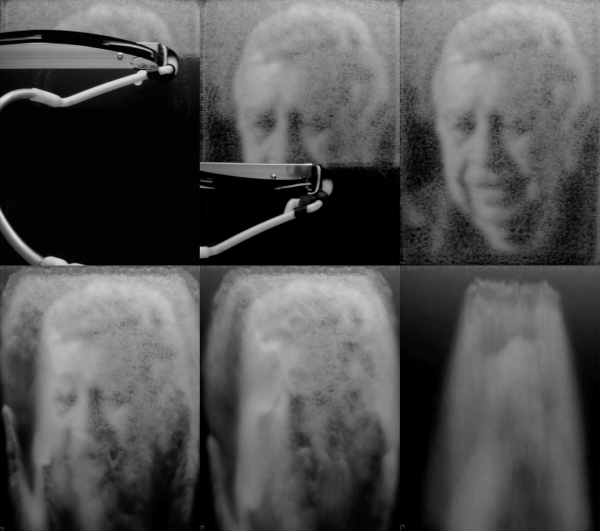“Soon, it will no longer be possible to delegate one’s death to others. It will no longer be possible for that person to die in our place. Not only will we condemned to assume our own demise, unmediated, but farewells will be few and far between. The hour of autophagy is upon us and, with it, the death of community, as there is no community worthy of its name in which saying one’s last farewell, that is remembering the living at the moment of death, becomes impossible.”
—Achille Mbembe, “The Universal Right to Breath,” translated by Carolyn Shread (Critical Inquiry 47, Winter 2021) Monuments and Anti-Monuments
About the Project
How do we memorialize and visualize the incredible loss a result of COVID-19, even as the pandemic persists? To answer this question, media artist Rafael Lozano-Hemmer offers A Crack in the Hourglass, An Ongoing COVID-19 Memorial, a participatory, transitory, and ongoing artwork. Initially commissioned by the Museo Universitario Arte Contemporáneo in Mexico City in 2020, and presented at the Brooklyn Museum in 2021-2022, the installation aims to create a space where people can gather, mourn, remember, and honor those lost to COVID-19. A Crack in the Hourglass will be on view in the Van Every/Smith Galleries between February 1-April 7, 2024, as part of a larger exhibition, The sun still rises in spite of everything.
Students, faculty, staff, alums, and the larger community are invited to submit photographs of their loved ones who died of COVID-19, accompanied by a dedication, through the project’s online platform. Then, visitors can watch—in person or via livestream—the robotic plotter recreate the image in sand. After the drawing is complete, the hourglass’s platform tilts; the image disappears and the sand is recovered to create the next portrait, in an effort to remind us that the pandemic is a collective experience, and one that is ongoing. While the sand drawings no longer exist in physical form, the names, written dedications and videos are archives on the project’s website. Some images will also be printed out and added to the gallery walls throughout the duration of the exhibition.
How to Participate
Lozano-Hemmer invites anyone to submit a photograph of a loved one who died due to COVID-19 along with a written dedication.
Anyone can submit images ahead of the installation of the project by clicking the button below.
After you submit, send us an email at linewman@davidson.edu so we can easily find your submission. Tell us your name and the name of your loved one.
Visitors to the exhibition at the Van Every/Smith Galleries are welcome to participate in person. In-person submissions will be prioritized in the queue so you can view the memorial while in the Galleries. The memorials will also be streamed live on the project’s website.
About the Artist
Rafael Lozano Hemmer (Mexican, b. 1967), received a B.Sc. in Physical Chemistry from Concordia University in Montréal, Canada. Working at the intersection of architecture and performance art, Lozano-Hemmer creates platforms for public participation using technologies such as robotic lights, digital fountains, computerized surveillance, media walls, and telematic networks. Inspired by phantasmagoria, carnival, and animatronics, his light and shadow works are “antimonuments for alien agency.” He was the first artist to represent Mexico at the Venice Biennale with an exhibition at Palazzo Van Axel in 2007. He has also shown at Biennials in Cuenca, Havana, Istanbul, Kochi, Liverpool, Melbourne NGV, Moscow, New Orleans, New York ICP, Seoul, Seville, Shanghai, Singapore, Sydney, and Wuzhen. His public art has been commissioned for the Millennium Celebrations in Mexico City (1999), the Expansion of the European Union in Dublin (2004), the Student Massacre Memorial in Tlatelolco (2008), the Vancouver Olympics (2010), the pre-opening exhibition of the Guggenheim in Abu Dhabi (2015), and the activation of the Raurica Roman Theatre in Basel (2018). Collections holding his work include MoMA and Guggenheim in New York, TATE in London, MAC and MBAM in Montreal, Jumex, and MUAC in Mexico City, DAROS in Zurich, MONA in Hobart, 21C Museum in Kanazawa, Borusan Contemporary in Istanbul, CIFO in Miami, MAG in Manchester, SFMOMA in San Francisco, ZKM in Karlsruhe, SAM in Singapore and many others. He has received two BAFTA British Academy Awards for Interactive Art in London, a Golden Nica at the Prix Ars Electronica in Austria, “Artist of the year” Rave Award from Wired Magazine, a Rockefeller fellowship, the Trophée des Lumières in Lyon, an International Bauhaus Award in Dessau, the title of Compagnon des Arts et des Lettres du Québec in Quebec, and the Governor General’s Award in Canada. He has lectured at Goldsmiths College, the Bartlett School, Princeton, Harvard, UC Berkeley, Cooper Union, USC, MIT MediaLab, Guggenheim Museum, LA MOCA, Netherlands Architecture Institute, Cornell, UPenn, SCAD, Danish Architecture Center, CCA in Montreal, ICA in London, and the Art Institute of Chicago. In the past few years, Lozano-Hemmer was the subject of more than 10 solo exhibitions worldwide, including a major show at the Hirshhorn Museum in Washington DC, the inaugural show at the AmorePacific Museum in Seoul, and a mid-career retrospective co-produced by the Musée d’Art Contemporain de Montréal and SFMOMA. In 2019 his immersive performance Atmospheric Memory premiered at the Manchester International Festival and his interactive installation Border Tuner connected people across the US-Mexico border using bridges of light controlled by the voices of participants in Ciudad Juárez, Chihuahua and El Paso, Texas.
Acknowledgements
This project was made possible through the support of the Bacca Foundation Visiting Scholar and Artist Program.

